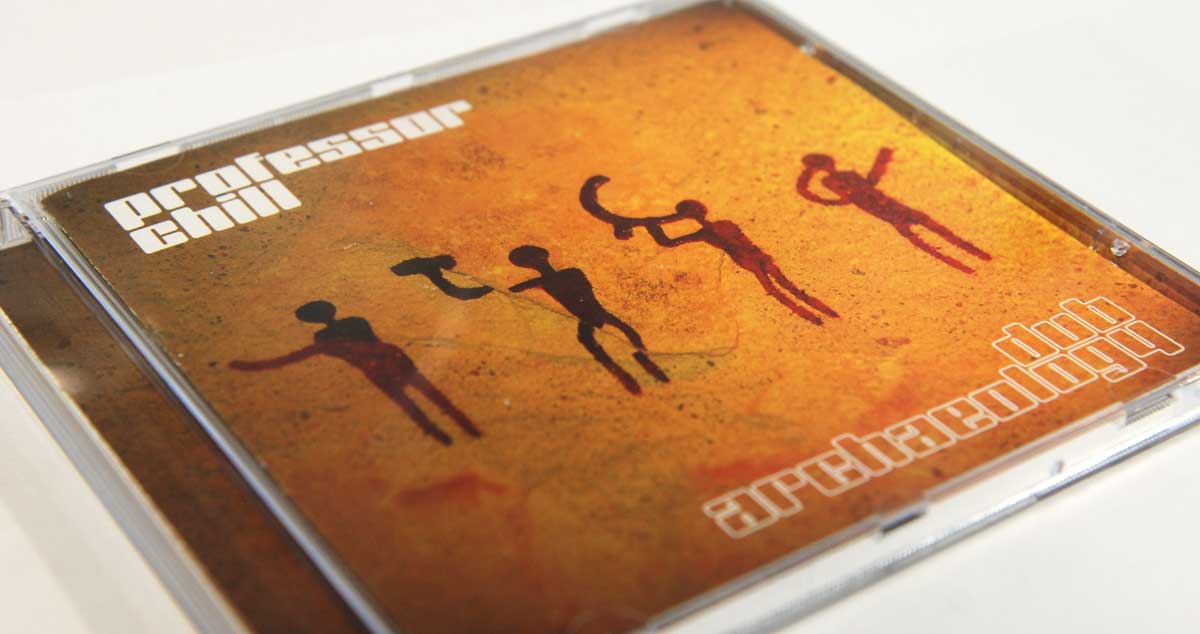Professor Rupert Till
Aka Professor Chill
Professor Rupert Till combines his two careers as an explorer of ancient music and major festivals DJ to create the CD, Dub Archaeology. “The more I went back in time the more I found that cultural differences between then and now began to dissolve,” said the Professor, who adopts the stage-name Professor Chill when appearing as a DJ at Festivals. “Ambient chillout music is all about creating an environment where you can separate yourself from your day-to-day life and connect with yourself and other people. And that’s exactly what was going on in ancient music. It was all about ritual and community and being together.”
MODERN festivalgoers chilling out to electronica have a lot in common with distant forbears who conjured up magical music in sacred sites and mysterious caves, according to a University of Huddersfield professor who has tied the threads together with a recording that combines ancient instruments, such as bone flutes and primitive bagpipes, with the latest DJ technology.
It is a product of Rupert Till’s parallel careers. As an academic, he is a professor who teaches and researches popular music and has been a key figure in a project to record a wide range of ancient European instruments and to investigate the acoustics of the places where they were played.
As a DJ who specialises in sets of ambient music at major festivals, he is known as Professor Chill. Now, his latest recording – titled Dub Archaeology – unites the two career strands by combining past and present in a sequence of eight tracks.
Sampled sounds of instruments that include the lur (a prehistoric trumpet), the lyre (a form of harp), the aulos (an ancient reed pipe) and flutes made from vulture bone are combined with ambient electronics and beats provided by Rupert Till in his Professor Chill persona.
Tracks have titles that hint at hypnotic soundscapes. They include Viking Bagpipe, Tombs of the Kings, Hengescape and Hymn to the Muse – a composition that can be dated to 300 BC, but with voice and lyre joined by brooding electronics.
The samples of prehistoric instruments on Dub Archaeology come from many of the same specialist players who contributed to a series of recordings produced by Professor Till for the European Music Archaeology Project (EMAP).
This has explored many cultures and time periods, and the series concludes later this year with a recording demonstrating the sounds of ancient Greece and Rome. The EMAP discs, on the Delphian label, have earned critical acclaim, with Ice and Longboats – music of ancient Scandinavia – entering the classical charts.
Dub Archaeology

One of Professor Till’s long-standing research projects has been to reconstruct the acoustic properties of Stonehenge, and for the EMAP series he recorded instruments played in locations that included the Tombs of the Kings – a World Heritage Site in Cyprus – and the Isturitz caves in France, where artefacts discovered included a pre-historic bone flute.
Some of these in situ samples are combined with electronics for Dub Archaeology. Professor Till believes the formula is perfectly natural.
“What I felt when I went into prehistoric caves, stone circles and chamber tombs was that the same things were happening thousands of years ago as are going on now,” he said.
“The more I went back in time the more I found that cultural differences between then and now began to dissolve. Ambient chillout music is all about creating an environment where you can separate yourself from your day-to-day life and connect with yourself and other people. And that’s exactly what was going on in ancient music. It was all about ritual and community and being together.”
This will happen when Professor Chill performs a two-hour set based on Dub Archaeology at the Samsara festival in Hungary. Earlier outings for the material have included a performance at the Boom Festival in Portugal, an event attended by 30,000. Such festivalgoers are fully open to his century-spanning source material.
“A lot of chillout ambient music tends to have world music contributions, such as sitars and different percussion instruments from around the world, so to have something from the past is just a different kind of separation,” says the Professor.
- Dub Archaeology by Professor Chill is available from 3 August on CD and vinyl from twin records. It is also downloadable from iTunes and can be streamed from Spotify after 3 August.
-
Free to stream for Spotify users:
-
£6.32 to download on iTunes:
https://geo.itunes.apple.com/gb/album/dub-archaeology/1404187831?mt=1&app=music
-
also available mail order on CD and Vinyl:
More news
Theorist Sethares inspires CD Beyond Pythagoras
Professor Monty Adkins explores a new method for developing harmony in electroacoustic music for his latest CD with composer Paulina Sundin
Phantom Images CD unites Huddersfield and Chicago
HCR label launches Phantom Images CD featuring contemporary composer Aaron Cassidy
Young composer chosen for New York workshop
Joel Kirk’s composition was played, analysed and discussed during the five-day workshop
£500k project sheds light of composer John Cage
Recordings by the University’s celebrated concert pianist Professor Paul Thomas receive critical acclaim
